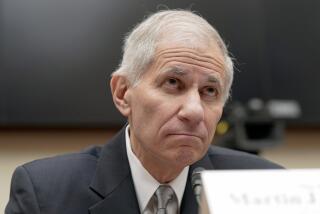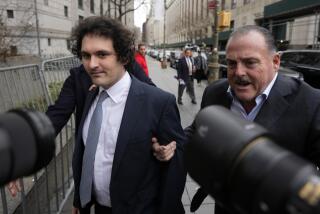FDIC seeks a $45-billion advance from banks to rebuild reserves
- Share via
WASHINGTON — Despite signs of economic improvement, banks continue to fail at a brisk pace, forcing regulators to scramble to keep the industry-financed deposit insurance fund from running out of cash.
With the fund technically falling into the red today, the Federal Deposit Insurance Corp. proposed Tuesday to require banks this year to prepay $45 billion, or more than three years’ worth, of insurance premiums.
The move would allow the FDIC to avoid drawing on a $500-billion line of credit the agency has with the Treasury Department.
“It’s clear that the American people would prefer to see an end to policies that look to the federal balance sheet as a remedy for every problem,” said FDIC chief Sheila C. Bair. “In choosing this path, it should be clear to the public that the industry will not simply tap the shoulder of the increasingly weary taxpayer.”
Insured bank deposits continue to be “100% safe,” Bair emphasized, and analysts agreed.
Kevin Petrasic, a former special counsel at the Office of Thrift Supervision, described the FDIC’s decision, which is open for public comment for 30 days, “as the least objectionable of some not particularly good options.”
Borrowing from the Treasury “would be viewed as yet another taxpayer bailout of the banking industry,” he said.
The deposit insurance fund, which insures accounts up to $250,000 in case a bank fails, is financed by premiums paid by financial institutions. But the fund has dropped below its mandated level as it has covered losses at 95 failed banks so far this year.
At the end of June, the fund had $45.2 billion, its lowest level since the end of the savings and loan crisis in 1993. The agency’s staff said the fund would have a negative balance as of today, after subtracting $32 billion set aside as of June 30 to cover losses at banks expected to fail over the following year.
Meanwhile, the cost of bank failures stemming from the financial crisis and the recession has been running higher than expected. The agency now projects that bank failures through 2013 will cost $100 billion, up sharply from the $70 billion projected in May.
As a result, without the proposed accelerated premium payments by banks, the FDIC says the fund will run out of cash in the first three months of next year, left only with troubled assets it cannot easily sell.
The FDIC seizes assets of failed banks and sells them to offset losses to the fund. But many of those assets are troubled loans.
The agency could raise more money for the fund by increasing the premiums that banks pay. But it has already done that once this year, and regulators are concerned another increase would hurt financial institutions’ balance sheets. Banking groups agreed.
“Another special assessment would likely do more harm than good, as it would directly reduce bank income, hinder capital growth and make lending much more difficult,” said James Chessen, chief economist at the American Bankers Assn., who noted banks would pay almost $17 billion into the fund in assessments this year, including a $5.6-billion increase in the second quarter.
So the FDIC board unanimously approved a plan to get an advance from the banks by having them prepay their premiums for the fourth quarter of this year and for 2010 to 2012.
Surprisingly, most banks won’t have trouble prepaying their premiums, analysts said. That’s because they have plenty of cash on hand but have been hesitant to lend it, fearing it won’t get repaid as unemployment continues to climb. In addition, accounting rules mitigate the effect of prepayment on the bank’s balance sheet, spreading out the effect on the bank’s earnings and assets.
Independent banking analyst Bert Ely described the prepayment as “essentially a non-interest-bearing loan” from the banks to the FDIC that is “politically more palatable” than tapping the government line of credit.
Bair has “stigmatized” the line of credit as a bailout, even though it would be backed by the failed bank assets held by the agency, Ely said.
The FDIC chief said she wanted the industry to solve the problem itself before turning to taxpayers.
“While we’re optimistic on the economy, if conditions unexpectedly worsen, we could reach a point when we would have to tap our Treasury line” of credit, Bair said. “But today is not that day. Our analysis suggests that the industry can step up, so we’re asking that they do so.”
--
More to Read
Inside the business of entertainment
The Wide Shot brings you news, analysis and insights on everything from streaming wars to production — and what it all means for the future.
You may occasionally receive promotional content from the Los Angeles Times.











